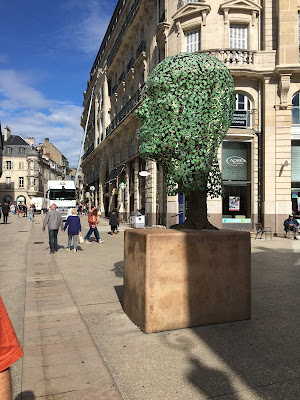 |
| Evidence that a batik bled |
When a fabric bleeds, it generally isn't good. Honestly, the best way to handle fabric bleeds is to prewash or test every fabric before you use it. This chicken project was a kit and some of the fabrics--the red that bled in particular--were so small that to have washed them and they shrank, I might not have had enough to cut the piece for the appliqué.
This was the first time that I purchased a kit. I liked the variety in the fabrics and the $20 each month I spent was less than I would have spent had I bought the individual fabrics on my own. Had I purchased yardage, I would have tested it. A fabric that bled would have been treated and retested. If it bled after a second treatment, I would have tossed it. In retrospect, I should have tested and treated each fabric. I should have substituted a fabric that I had rather than trying to stay true to the fabrics I was given in the kit.
 |
| The bleed after Tsukeno ink applications |
Knowing what I do now, I will prewash or test all fabrics in the future! Yes, it made me sad that a black ran onto the cream background, a purple ran on the cream background, a green ran on a wood background and a red ran onto a cream background.
Even though I had rinsed the blocks after I had appliquéd them, I still had a few spots where the dye ran. Ugly!!! I tried a synthropol treatment; but it didn't help and I tried Dawn. . .it helped a little.
I've been asked why I didn't use Retayne instead of Synthropol. You can get a little information
here.
I felt that the Synthropol would remove the dye particles that were affixing themselves to areas that I didn't want. The Retayne would affix the dye to the quilt which was a process that I didn't want!
 |
| The bleed after the acrylic paint applications |
I've been trying to figure out why the colors ran this time when they didn't run before. I think, that over time, our water has changed. I know that there is more chlorine in it now than there was a decade ago. I forgot all about that change. I should have used filtered water. Maybe I can remember that for the next time I wash or get a quilt wet!
After the Dawn detergent trial, my next idea was to paint over the areas. Hey, paint covers lots of issues. I used Tsukneko white all purpose ink to cover that fabric bleed. Three coats helped; but, the fabric bleed was too evident for me.
 |
| Sample of where a black fabric bled |
Next, I tried white acrylic paint. I have about three layers of paint here too! The acrylic paint changed the hand of the fabric a bit; but, not enough for it to bother me more than the fabric that bled! It took some time because I had to wait after each paint application for the fabric to dry which generally meant waiting overnight!
In the other areas where the fabrics bled, I tried the same applications. Unfortunately, I didn't have as much success. On line, I purchased several rubber stamps of chicken or bird tracks and considered inking images on the front of the quilt to "cover" the problems. My thought that a few chicken tracks could camouflage that ink bleed.
 |
Chicken tracks stamped on practice
sample |
I used an archival ink pad. My first test was on my practice/test sample. I was surprised that the ink bled into the cotton fabric as much as it did. The edges just weren't clear on the stamped image. Next, I wondered what it would look like if I stamped a bunch of images in an area. I decided it looked liked a mess.
 |
| Chicken sample--to much bleeding |
I even stamped the ink on the project. No, I didn't stamp on the front of the project because I may be crazy; but, I didn't want to be committed if I didn't like what was happening!
 |
Stamping a bunch of images in an area
sample |
Unfortunately, the stamping test on the back of the quilt netted the same results as it did stamping on my practice sample.
I stepped a foot back from the quilt and looked. Yes, I can see that the fabric bled because I know it is there; but, I also think that there is enough quilting, pattern and fabrics to take your eye other places in the quilt. I decided. . . .the chicken wall hanging was good enough as is. So I didn't add any chicken tracks, although it was a great idea!
 |
The bleed is just above the feather with the
bottom black square |
My "stamping experiment" will be covered with the hanging sleeve. I have about half of the sleeve left to hand stitch. Perhaps, the finished wall hanging will be the subject of my next post. . . .keep your fingers crossed!























































